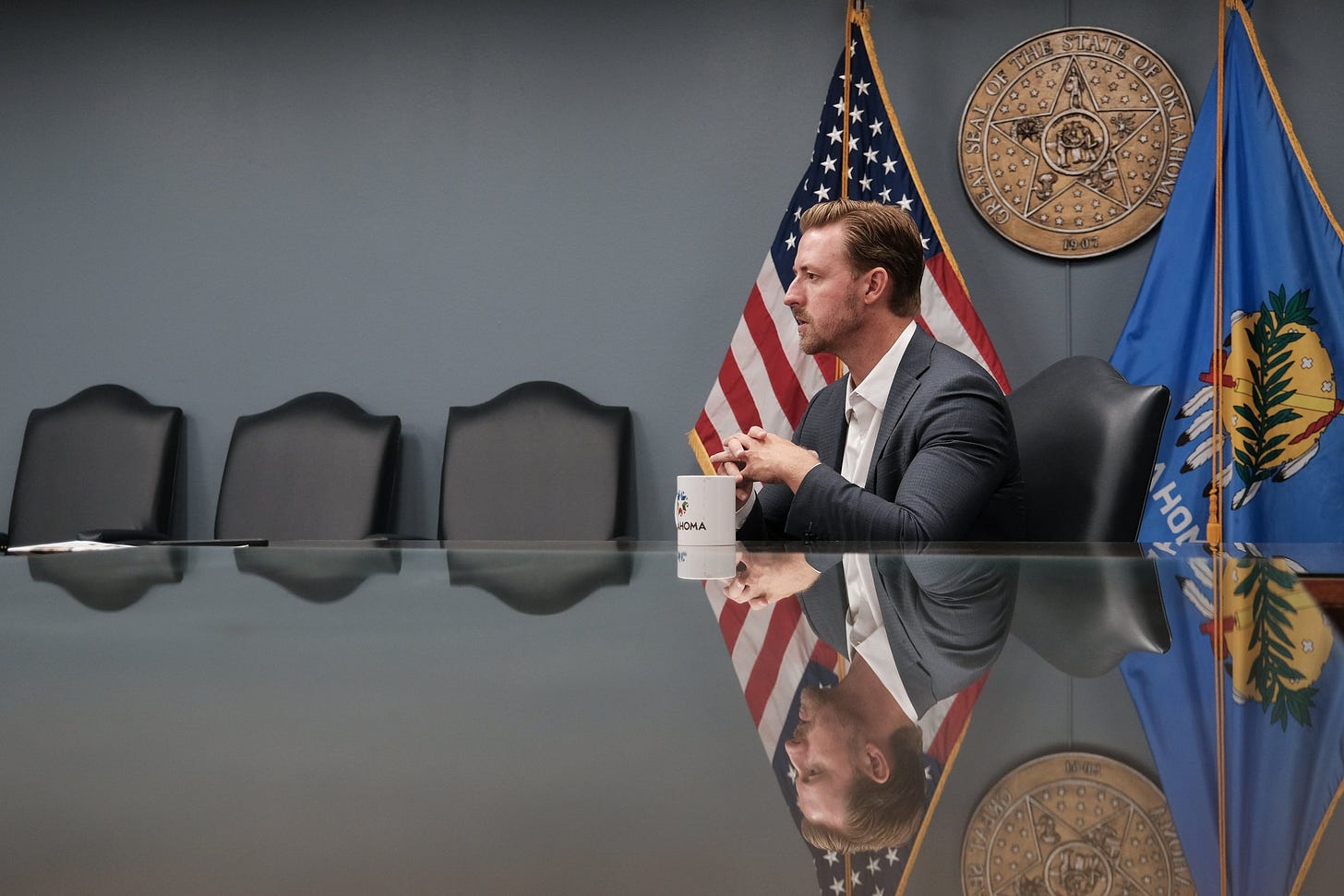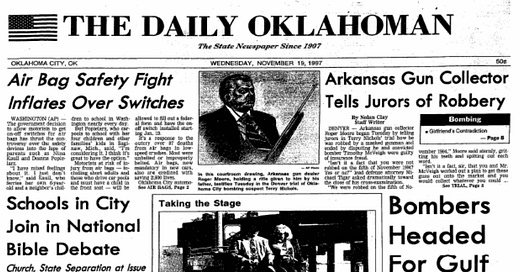🚸 To understand the wrangling over religion in public schools, consider these 3 questions 🔌
Culture wars turn classrooms into battlefields
By Bobby Ross Jr.
OKLAHOMA CITY — Before I got my start in religion reporting 25 years ago, I covered education news for The Oklahoman, the daily newspaper in Oklahoma City.
Way back in 1997, I did a piece on the national debate over teaching the Bible in public schools.
In 1999, I delved into the hot-button topic of school vouchers. The question: Should parents be able to tap public funding to send children to religious schools?
A quarter-century later, the culture wars over such issues have not disappeared.
If anything, such fights have intensified.
Just this week, USA Today’s Kayla Jimenez and Murray Evans explored why GOP leaders in states such as Louisiana, Oklahoma and Texas are pushing religion in public schools.
In a similar piece, Reuters’ Liya Cui and Joseph Ax tackled “How U.S. public schools became a new religious battleground.”
For my part, my background in education and religion writing came in handy as I profiled Ryan Walters for The Christian Chronicle. Walters is Oklahoma’s superintendent of public instruction, overseeing a $4 billion-a-year educational system with 700,000 students.

This summer, a week after Louisiana leaders directed every classroom to display the Ten Commandments, Walters ignited a national furor with a mandate requiring Oklahoma schools to incorporate the Bible into academic instruction.
For those seeking to understand the wrangling over religion in public schools, consider these three questions:
— What do politicians such as Walters mean when they talk about “putting the Bible back in our schools?”
The Pew Research Center offers an excellent primer on the history of battles over religion in America’s schools.
A crucial chunk of context from Pew:
Conflicts over religion in school are hardly new. In the 19th century, Protestants and Catholics frequently fought over Bible reading and prayer in public schools. The disputes then were over which Bible and which prayers were appropriate to use in the classroom. Some Catholics were troubled that the schools’ reading materials included the King James version of the Bible, which was favored by Protestants. In 1844, fighting broke out between Protestants and Catholics in Philadelphia; a number of people died in the violence and several Catholic churches were burned. Similar conflicts erupted during the 1850s in Boston and other parts of New England. In the early 20th century, liberal Protestants and their secular allies battled religious conservatives over whether students in biology classes should be taught Charles Darwin’s theory of evolution.
Check out the full primer (it’s an easy and relatively quick read) for helpful insight on various U.S. Supreme Court decisions concerning prayer and religion in schools.
Do note this: The Pew piece was published in 2019 so doesn’t include more recent cases such as a Washington state high school football coach winning the right in 2022 to kneel on the field for postgame prayer.

— Why is the push for placing the Ten Commandments and the Bible in public school classrooms happening now?
Reuters noted:
The movement is fueled by opposition to what conservatives call liberal curriculums, including a focus on diversity and LGBT rights, and by the U.S. Supreme Court's willingness to overturn precedent as it moves American law rightward.
A critic of Walters whom I interviewed — Oklahoma state Rep. Mark McBride, who is a Republican and a longtime Southern Baptist — voiced concern that classrooms have become battlefields.
“I want people to go to school and learn reading, writing and arithmetic and not have the distraction of having to be taught the Bible in school,” McBride told me. “But I don’t want the gay pride flag in the classroom either.”
I quoted Lori Windham, vice president and senior counsel at religious liberty law firm Becket, in my recent Plug-in column on released time religious instruction.
Such programs, as you may recall, allow students to be released from public schools during the school day to study the Bible or another religious text, such as the Quran or the Book of Mormon. A 1952 Supreme Court decision set the legal precedent that governs released time.
“The Supreme Court approved released time back in the 1950s when you had a very separationist Supreme Court that was really policing the boundaries of religion in schools,” Windham told me. “Now we have courts who recognize that religious expression in schools is OK.”
To put it another way: The court’s conservative majority gives religious mandates in states such as Louisiana and Oklahoma “a better shot at prevailing,” according to a prominent law professor quoted by USA Today.

— How can the Bible — viewed as sacred by Christians — be incorporated into the academic curriculum in a secular, neutral way? And should it be?
Oklahoma’s Walters issued instructional guidelines for teachers suggesting that a “holistic approach ensures that students do not merely see the Bible as a religious text but as a significant historical and cultural artifact that has influenced a wide array of human endeavors.”
But McBride, the state representative I mentioned earlier, asked: “Whose faith are you going to teach? The Church of Christ is a little bit different than the Southern Baptists, and the Southern Baptists are different from the Mormons. So where do you draw the line?”
And which version of the Bible would be taught? New International? King James? Catholic? (The Protestants and Catholics who fought in the 19th century would really like to know the answer.)
In an interview with the New York Times, Walters “said he would not favor a particular version of the Bible. And he said the book, unlike other religious texts, such as the Quran, played a unique role in (America’s) founding and culture.”
I also interviewed Oklahoma state Rep. Mike Osburn. He is a Republican and a Christian. He got his start in Republican politics 30 years ago.
“Treating the Bible as only a historical document trivializes what I believe is a sacred text and the inspired word of God,” Osburn told me. “The risk of this sacred text being further compromised by mandating that all teachers, including believers and nonbelievers, explain the Bible is another concern.”
Look for such controversies to remain prominent in the news.
Like it or not, fights over religion in public schools seem unlikely to vanish any time soon.
Inside the Godbeat
A “Minnesota Lutheran” burst into the headlines this week.
That’s how some Godbeat pros — including Religion Unplugged’s own Clemente Lisi — characterized Minnesota Gov. Tim Walz, Vice President Kamala Harris’ pick to join her on the Democratic ticket.
I loved this Walz quote that Lisi, Religion News Service’s Jack Jenkins, Christianity Today’s Harvest Prude, the Deseret News’ Kelsey Dallas and others cited: “Because we’re good Minnesota Lutherans, we have a rule: If you do something good and talk about it, it no longer counts. So what you have to do is to get someone else to talk about you.”
Read more on Walz’s faith from The Tennessean’s Liam Adams.
Speaking of Walz, my friend Bob Smietana of Religion News Service wants to know: “If Walz is elected, would he become the first bald VP since Cheney?”
Thank you, Bob.
We know we can count on you to ask the important, probing questions.
The final plug
The Associated Press’ Holly Meyer wrote a fascinating feature on how a Texas church is supporting two members — both astronauts — who are working together on the International Space Station.
Meyer’s story reminded me of the interview I did a few years ago with astronaut Victor Glover, who took communion cups with him to space in 2020 — and presumably will again when he pilots the first crewed moon mission in more than 50 years.
Happy Friday, everyone! Enjoy the weekend.
Bobby Ross Jr. writes the Weekend Plug-in column for Religion Unplugged and serves as editor-in-chief of The Christian Chronicle. A former religion writer for The Associated Press and The Oklahoman, Ross has reported from all 50 states and 18 nations. He has covered religion since 1999.




